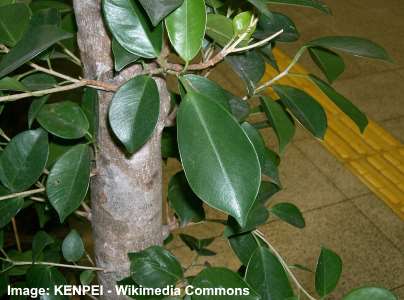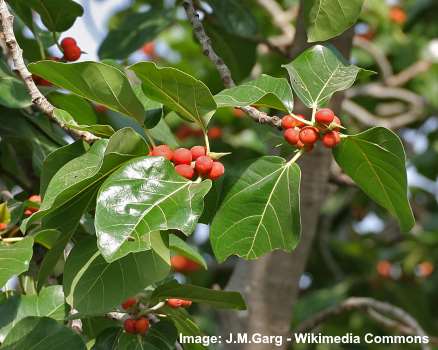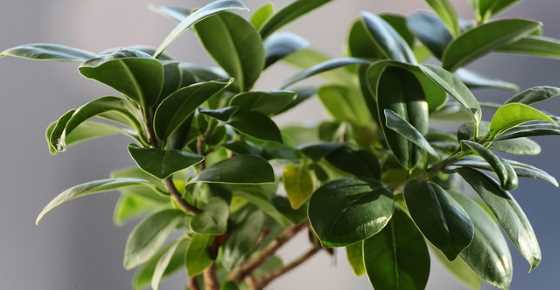There are many types of ficus trees that make great houseplants and can also add greenery to your garden. In general, most varieties of ficus plants are easy to care for. Types of ficus trees include shrub-like plants, creeping vines, and woody trees.
Ficus plants may be large banyan trees, fig trees, or laurel trees when grown outdoors. Fiddle-leaf fig, rubber plant, Audrey ficus, and weeping fig are all popular indoor varieties of ficus trees. Indoor ficus trees are so popular because they may be used to meet a broad range of interior design requirements and are adaptable.
You’ll learn about several forms of ficus trees, which may add luster to your home or garden, in this article.
Types of Ficus Trees and Plants (With Pictures and Names)
The ficus genus contains roughly 850 plant species. The Moraceae family includes woody trees, vines, shrubs, and plants. Plants in the ficus genus are usually found in a wide range of habitats. Ficus plants of certain varieties thrive in warm weather. Houseplants are better suited for other types of ficus plants.
The ficus species ‘Weeping fig’ (Ficus benjamina) is usually referred to when individuals discuss a “ficus” plant. Ficus trees, large banyan trees, and the humble houseplant Rubber plant are all fig fruit trees in the ficus genus.
Outdoor Ficus Trees
Ficus trees come in a variety of shapes and sizes, so let’s take a look at some of them. It’s also a good idea to remember that certain ficus types make excellent house plants.
Sacred Fig

The Sacred Fig (Ficus religiosa) is a fast-growing ficus species that thrives in full sun. The Sacred fig’s heart-shaped leaves are its distinguishing characteristic.
This kind of outdoor ficus tree, if treated carefully, may grow into a lovely decorative tree in a garden or yard. The Holy fig grows well in full Sun like many other ficus species. This form of ficus tree may be kept to a reasonable height by trimming it regularly throughout the winter and spring.
Mistletoe Fig

The Mistletoe fig (Ficus deltoidea) is a ficus cultivar with thick waxy delta-shaped leaves that has a spreading habit. This ficus shrublike tree, which grows to a height of about 6.5 feet (2 meters), is found outdoors. You can use the Mistletoe fig to create a lot of ground cover because it has a spreading quality.
The Mistletoe fig, on the other hand, requires a warm environment to flourish outdoors. This ficus tree can also be kept as a houseplant indoors. When the ficus shrub is grown in bright sunlight, it produces little red-colored figs, which is one of the intriguing characteristics.
Indian Laurel

The Indian Laurel (Ficus microcarpa) is a ficus tree that belongs to the Ficus family. It thrives in humid, warm climates. Indian Laurel requires subtropical and tropical environments to thrive as an outdoor ficus tree. To provide plenty of shade in gardens, this kind of ficus plant may be pruned to resemble an ornamental tree.
Cof Carmels of the Ficus microcarpa are popular houseplants because they need a warm humid environment like the Indian Laurel. Bonsai ficus miniature trees of the Indian Laurel variety are also common.
The Ficus Emerald Green cultivar is particularly noteworthy. The foliage of this tiny ficus tree may be trimmed to resemble a big green glossy ball, and the stem is thin and sturdy. This specimen is commonly known as a “lollipop” because of its ficus tree shape.
Common Fig

In temperate regions, the common fig tree is known as the ficus carica plant and belongs to the ficus family of plants. Fig trees, of course, are well-known for producing sweet fig fruits in Middle Eastern and Mediterranean countries. Even if you reside in cooler regions, you may cultivate ficus shrub tree cultivars.
USDA hardiness zones 5 and 6 may be appropriate for decorative ficus carica fig trees like ‘Brown Turkey’ and ‘Chicago Hardy.’ Ficus fig trees’ spreading nature also makes them useful shade in your yard.
Indoor Ficus Trees and Plants (With Pictures and Names)
Indoors, you may cultivate tree-type ficus plants as houseplants. Let’s take a look at some of the most popular ficus houseplants.
Audrey Ficus

Audrey ficus (Ficus benghalensis) is a tree ficus species that has luscious dark green velvety leaves and striking cream-colored veins. It is classified as a species of tree ficus for both indoors and out. Even though it may grow to be rather tall outdoors, this sort of ficus tree may be kept as a fairly compact indoor plant since it will not expand nearly as much indoors.
This little indoor ficus tree plant should be exposed to sufficient light if it is in your home. You should protect this indoor ficus tree from long periods of direct sunlight, despite the fact that it enjoys bright locations. Audrey ficus plant is a suitable houseplant because it is readily cared for. The Audrey ficus isn’t especially picky, when compared to the Fiddle-leaf fig.
Fiddle-Leaf Fig

The Fiddle-Leaf fig (Ficus lyrata) is a slow-growing indoor ficus tree that may be maintained as a house herb. This is a magnificent indoor specimen plant with large green leaves. The violin-shaped leaves of this kind of ficus tree are a deep glossy green color, one of the distinguishing features.
This is an attractive house plant that develops over time. It’s a slow-growing ficus tree. Up to 9.8 ft. (3 m) indoors, the long slender trunk may grow. The Fiddle-leaf can grow up to 50 feet (15 meters) tall and has a bushy appearance when it grows outdoors.
The Fiddle-leaf ficus is a popular houseplant, but it is demanding and difficult to care for. In a warm environment, the ficus should get sufficient light and regular watering. It, on the other hand, is susceptible to environmental variations and should be kept away from drafts and vents.
Narrow-Leafed Fig

The Narrow Leaf fig (Ficus maclellandii ‘Alii) is another ficus tree that grows well indoors and is relatively easy to care for. The Banana fig, Alii fig, or Banana-leaf ficus is another name for this plant.
Long stems and large leaves give this evergreen houseplant the appearance of a bushy indoor tree. The leaves are broad and thin, growing from 3 to 5 inches (8-13 cm). This plant’s attractive feature is the long drooping leaves. The plant might grow up to 10 feet (3 meters) tall in ideal circumstances. You may, however, keep its height significantly lower with yearly pruning.
To create an attractive indoor ficus tree plant, the long spindly stems or trunks may be braided or pleated. The Narrow Leaf fig is relatively easy to care for when compared to other ficus types. The soil should be watered frequently while it is in indirect sunlight. To keep the leaves from falling off, rotate this little ficus tree weekly if you stand it against a wall.
Rubber Plant

The Rubber tree (Ficus elastica) is a popular kind of leafy indoor plant with huge gorgeous leaves. This is the kind of ficus that most people prefer because it is easiest to care for. According to Feng Shui, it’s also a lucky plant.
The rubber plant has 12-inch (30 cm) long attractive leaves. From dark green with maroon veins to dark reddish-brown with green edging, the leaves can be a variety of colors. When growing the Rubber plant indoors, you don’t have to be concerned about its size when it grows outdoors, even though it is a huge “rubber” plant. The Ficus elastica averages 1 to 2 feet (30 to 60 cm) in height. As a result, this beautiful indoor small ficus tree may be used as a center piece for a table or window ledge.
However, you may allow the Rubber plant to grow as tall as 8 feet (2.4 meters) indoors if you prefer. The Rubber plant thrives in bright, indirect light, as do most types of indoor ficus plants. It should be planted in pots or containers with a drainage hole in the bottom.
Beautiful ornamental houseplants can also be grown from various Ficus elastica cultivars. Leathery green leaves with creamy-white edging, for example, are found on the Ficus elastica ‘Variegata’. The dark burgundy thick glossy leaves of the Ficus elastica ‘Black Prince’ are stunning.

Ficus elastica cultivars include ‘Variegata’ (left) and ‘Black Prince’ (right)
Weeping Fig

The indoor ficus plant the Weeping fig is very popular. The Weeping fig (Ficus benjamina) with its green glossy leaves and bushy appearance is a popular ficus cultivar for indoors. The Weeping fig has small leaves, and most people refer to it as “ficus.” They develop into a tiny shrub-like tree that is quite ornamental as they grow. Trained to grow how you want them, the thin flexible trunks are also possible. Braid the trunks of the Weeping fig to encourage its growth.
The Weeping fig is one of the most simple-to-care-for indoor ficus plants. It grows in low light and little water, despite the fact that it requires a lot of light. Moving its position and drafts can stress Weeping fig plant, as it is with many types of indoor ficus plants. Watering a Weeping fig once a week to keep the soil moist is important for its health.
In addition, the Ficus benjamina species has a variety of decorative ficus plants. The cultivar of the weeping fig known as the ‘Starlight’ Weeping fig is a bushy plant with tiny white and green leaves that is, for example, a weeping fig cultivar. The slow-growing ‘Too Little’ Weeping fig is another small ficus tree. The leaves on this compact tree are curled up and tiny.
Creeping Fig

The Creeping fig (Ficus pumila) is a woody creeping ficus vine that thrives in both indoor and outdoor environments. The little heart-shaped leaves and rapid climbing development of the Creeping fig are its defining characteristics. This ficus variety thrives in pots with dangling green leaves due to its ‘creeping’ nature. As a result, hanging basket or shelf replicas of creeping fig plants are suitable indoors.
The Creeping fig may also be grown on a moss pole in your home. This kind of ficus houseplant is particularly simple to grow, which is one of its great features. The Creeping fig, like most ficus plants, thrives in indirect sunlight and moist soil. It requires plenty of light. The little woody stems, on the other hand, are susceptible to pruning.
Outside, this is a hardy ficus variety to cultivate. It is hardy down to 34°F (1°C), even though it does not tolerate frost well. This climbing ficus vine may be used to provide ground cover in shady places where you need it. You can also teach it to develop up walls and trellises, like ivy does.
The ficus pumila ‘Curly’ cultivar with its tiny cream and green-colored leaves is another cultivar from the species. Another is a white and green-leaved slow-growing variety of creeping ficus with crinkly edges called the ‘Snowflake.
Ficus Daniella

The Ficus Daniella (also known as Ficus Moclame) is a ficus with thick waxy leaves that prefers to be grown indoors. Thicker waxy leaves give this kind of ficus a lovely oval shape. The Daniella ficus prefers bright light but not direct sunlight, as do most kinds of indoor ficus trees. Regular misting helps the ficus plant flourish by keeping the environment humid enough. Additionally, the leaves may fall off if the plant moves.
Ficus Tree Plant Care
Providing the appropriate conditions for your ficus trees to thrive is generally simple. The following are some of the finest ways to look after your ficus plants.
How to care for a ficus plant indoors
The light, soil, and pruning are the most essential elements to consider for your indoor ficus trees.
Soil. Loamy soil that drains well is the best kind of soil for your indoor ficus plants to grow in. There should be enough holes in the pot to allow water to drain.
Light. The majority of indoor ficus plants need bright light. Ficus leaves, on the other hand, can be scorched by direct sunlight and wilt. It’s also a good idea to periodically rotate the container to promote uniform development.
Water. Water your ficus once a week during the summer months. If the leaves of your ficus houseplant turn yellow, this is a sure sign that you are watering it too much. Misting the leaves on a regular basis may also help to increase humidity.
Pruning. Spring and winter are the best seasons to trim your ficus tree indoors. This may help keep your indoor tree at a proper height while it grows. New leaf development and a bushy form of ficus tree are benefits of regular pruning.
Outdoor ficus plant tree care
Ficus trees, when grown in their native environment, may reach a tremendous height and provide a lot of cover. Ficus trees make excellent ornamental plants or specimen trees in your yard or garden. Ficus trees can only survive in USDA hardiness zones 10 and 11 because they are native to tropical and warm climates. Also, since their root system may damage buildings and sidewalks, you may want to grow them in huge pots.
Where to plant a ficus tree outdoors. Outdoors, a ficus tree should be sheltered from the wind and sunlight.
Soil and watering. A ficus tree grown outdoors requires loamy soil that drains well, much as indoor ficus plants do. Make sure that water drains easily from the pot when planting in a container. Container-grown plants limit the height of the plant as well.
Pruning. The only reason to perform pruning on an outdoor-growing ficus tree is to encourage development or construct a lovely barrier.
